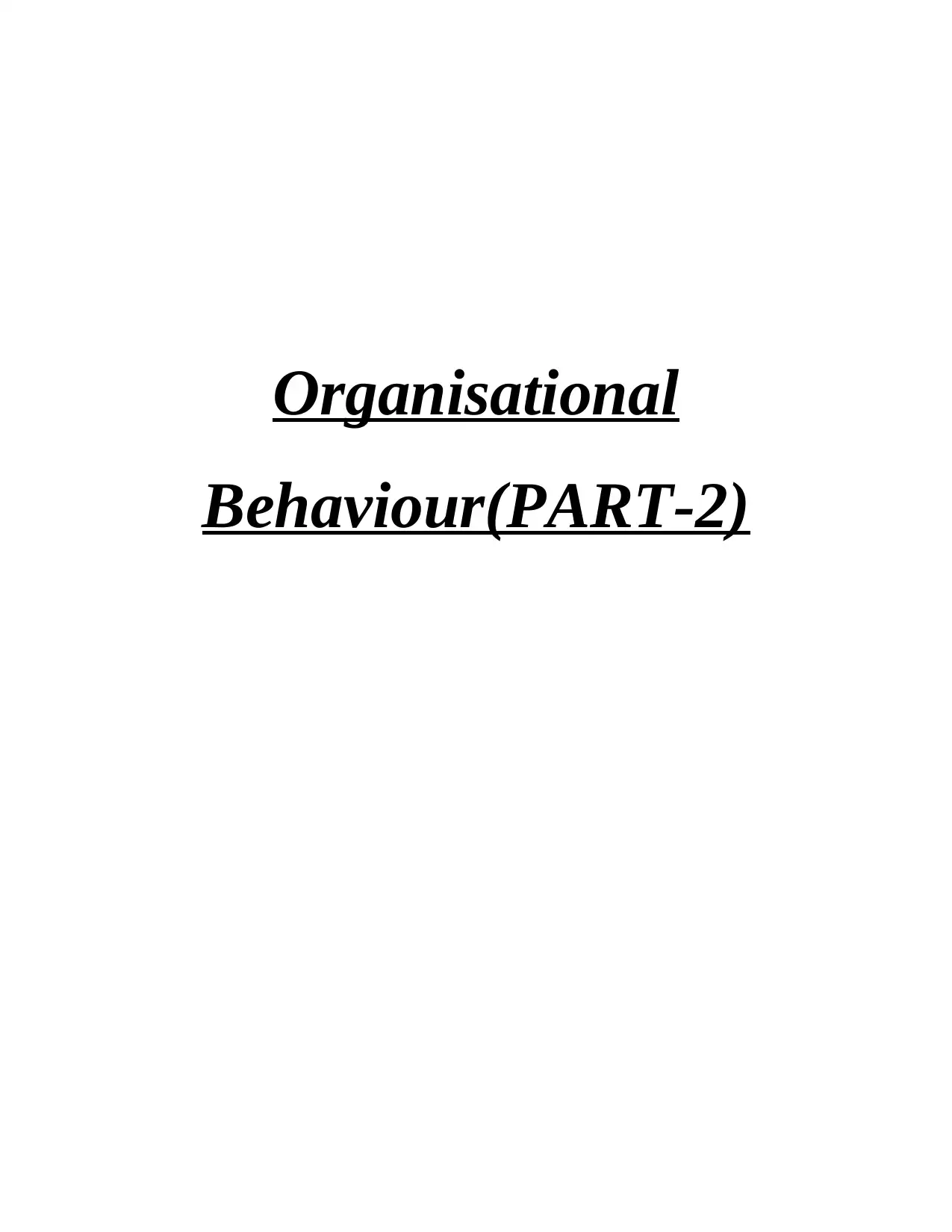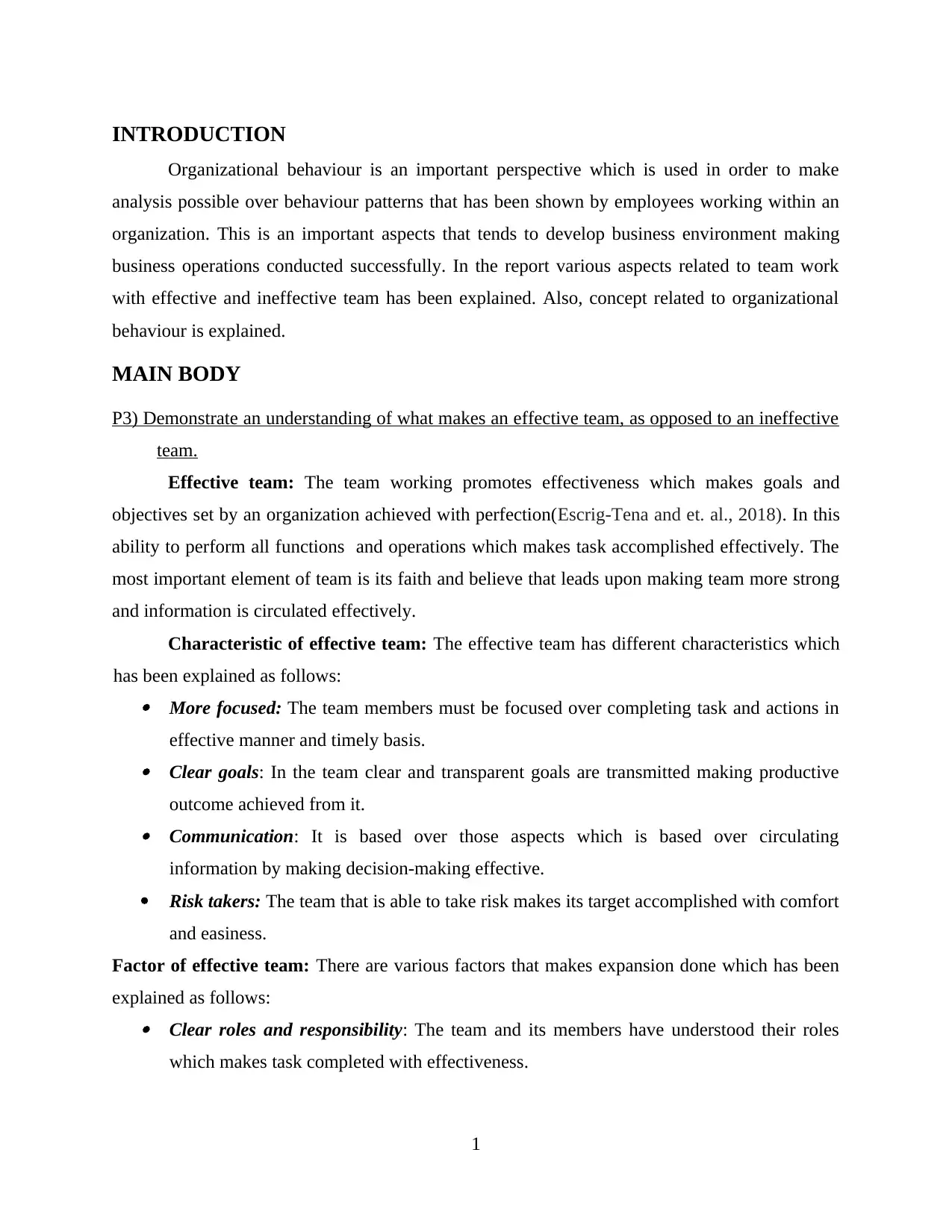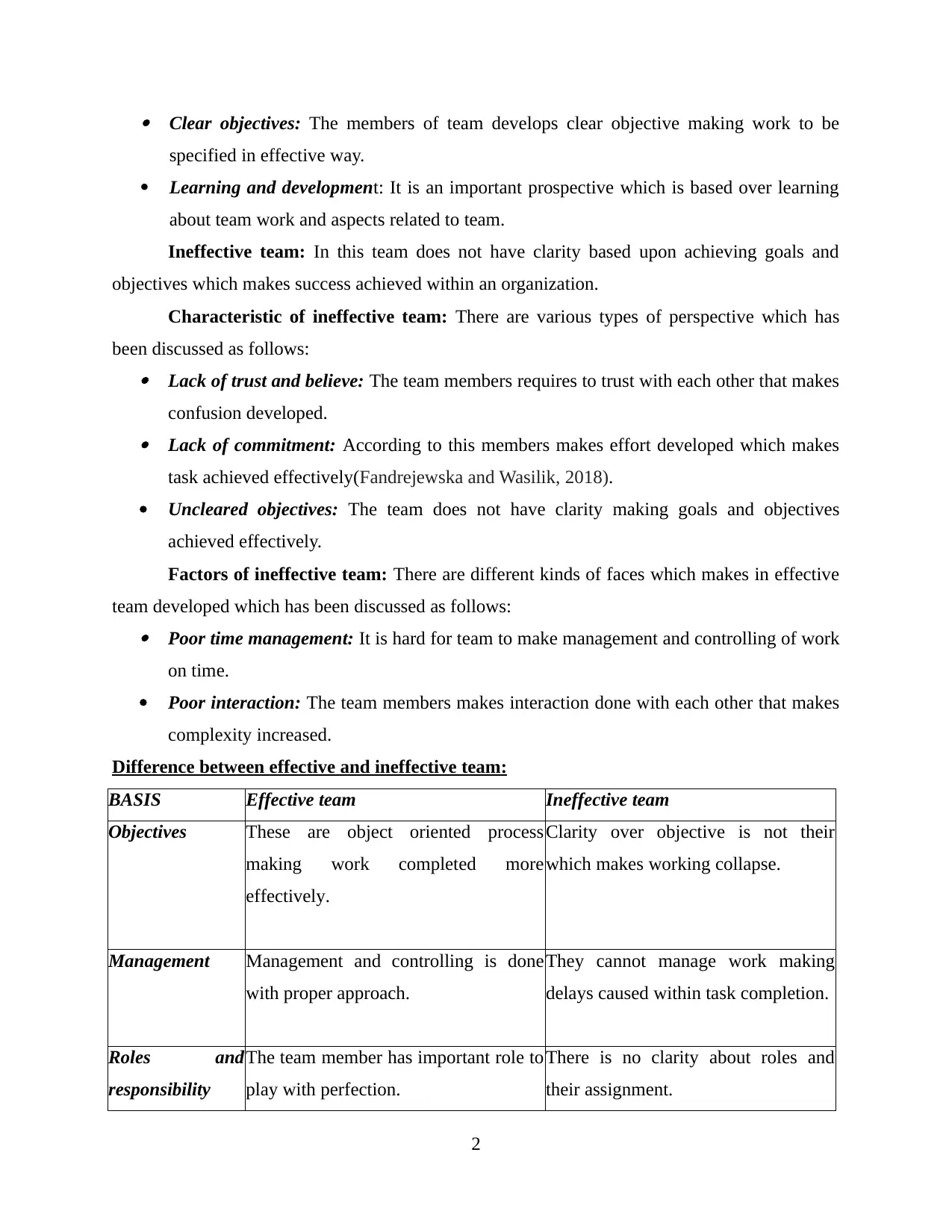Organisational Behaviour: Team Dynamics and Application of OB
VerifiedAdded on 2023/06/04
|9
|1819
|373
Report
AI Summary
This report provides an analysis of organisational behaviour, focusing on the characteristics of effective and ineffective teams and the application of organisational behaviour concepts within a business context. It highlights the importance of factors such as clear goals, communication, trust, and risk-taking in effective teams, while also discussing the pitfalls of poor time management and lack of commitment in ineffective teams. The report also touches upon Belbin's team role theory, emphasizing the importance of understanding individual strengths and weaknesses within a team. Furthermore, it applies the path-goal theory of leadership, discussing how different leadership styles can motivate employees and enhance their performance. The study concludes by underscoring the significance of organisational behaviour in shaping positive working patterns and achieving business objectives.

Organisational
Behaviour(PART-2)
Behaviour(PART-2)
Paraphrase This Document
Need a fresh take? Get an instant paraphrase of this document with our AI Paraphraser

Table of Contents
INTRODUCTION...........................................................................................................................1
MAIN BODY ..................................................................................................................................1
P3) Demonstrate an understanding of what makes an effective team, as opposed to an
ineffective team............................................................................................................................1
P4) Apply concepts and philosophies of OB within an organisational context and a given
business situation.........................................................................................................................3
CONCLUSION ...............................................................................................................................5
REFERENCES................................................................................................................................6
INTRODUCTION...........................................................................................................................1
MAIN BODY ..................................................................................................................................1
P3) Demonstrate an understanding of what makes an effective team, as opposed to an
ineffective team............................................................................................................................1
P4) Apply concepts and philosophies of OB within an organisational context and a given
business situation.........................................................................................................................3
CONCLUSION ...............................................................................................................................5
REFERENCES................................................................................................................................6

⊘ This is a preview!⊘
Do you want full access?
Subscribe today to unlock all pages.

Trusted by 1+ million students worldwide

INTRODUCTION
Organizational behaviour is an important perspective which is used in order to make
analysis possible over behaviour patterns that has been shown by employees working within an
organization. This is an important aspects that tends to develop business environment making
business operations conducted successfully. In the report various aspects related to team work
with effective and ineffective team has been explained. Also, concept related to organizational
behaviour is explained.
MAIN BODY
P3) Demonstrate an understanding of what makes an effective team, as opposed to an ineffective
team.
Effective team: The team working promotes effectiveness which makes goals and
objectives set by an organization achieved with perfection(Escrig-Tena and et. al., 2018). In this
ability to perform all functions and operations which makes task accomplished effectively. The
most important element of team is its faith and believe that leads upon making team more strong
and information is circulated effectively.
Characteristic of effective team: The effective team has different characteristics which
has been explained as follows: More focused: The team members must be focused over completing task and actions in
effective manner and timely basis. Clear goals: In the team clear and transparent goals are transmitted making productive
outcome achieved from it. Communication: It is based over those aspects which is based over circulating
information by making decision-making effective.
Risk takers: The team that is able to take risk makes its target accomplished with comfort
and easiness.
Factor of effective team: There are various factors that makes expansion done which has been
explained as follows: Clear roles and responsibility: The team and its members have understood their roles
which makes task completed with effectiveness.
1
Organizational behaviour is an important perspective which is used in order to make
analysis possible over behaviour patterns that has been shown by employees working within an
organization. This is an important aspects that tends to develop business environment making
business operations conducted successfully. In the report various aspects related to team work
with effective and ineffective team has been explained. Also, concept related to organizational
behaviour is explained.
MAIN BODY
P3) Demonstrate an understanding of what makes an effective team, as opposed to an ineffective
team.
Effective team: The team working promotes effectiveness which makes goals and
objectives set by an organization achieved with perfection(Escrig-Tena and et. al., 2018). In this
ability to perform all functions and operations which makes task accomplished effectively. The
most important element of team is its faith and believe that leads upon making team more strong
and information is circulated effectively.
Characteristic of effective team: The effective team has different characteristics which
has been explained as follows: More focused: The team members must be focused over completing task and actions in
effective manner and timely basis. Clear goals: In the team clear and transparent goals are transmitted making productive
outcome achieved from it. Communication: It is based over those aspects which is based over circulating
information by making decision-making effective.
Risk takers: The team that is able to take risk makes its target accomplished with comfort
and easiness.
Factor of effective team: There are various factors that makes expansion done which has been
explained as follows: Clear roles and responsibility: The team and its members have understood their roles
which makes task completed with effectiveness.
1
Paraphrase This Document
Need a fresh take? Get an instant paraphrase of this document with our AI Paraphraser

Clear objectives: The members of team develops clear objective making work to be
specified in effective way.
Learning and development: It is an important prospective which is based over learning
about team work and aspects related to team.
Ineffective team: In this team does not have clarity based upon achieving goals and
objectives which makes success achieved within an organization.
Characteristic of ineffective team: There are various types of perspective which has
been discussed as follows: Lack of trust and believe: The team members requires to trust with each other that makes
confusion developed. Lack of commitment: According to this members makes effort developed which makes
task achieved effectively(Fandrejewska and Wasilik, 2018).
Uncleared objectives: The team does not have clarity making goals and objectives
achieved effectively.
Factors of ineffective team: There are different kinds of faces which makes in effective
team developed which has been discussed as follows: Poor time management: It is hard for team to make management and controlling of work
on time.
Poor interaction: The team members makes interaction done with each other that makes
complexity increased.
Difference between effective and ineffective team:
BASIS Effective team Ineffective team
Objectives These are object oriented process
making work completed more
effectively.
Clarity over objective is not their
which makes working collapse.
Management Management and controlling is done
with proper approach.
They cannot manage work making
delays caused within task completion.
Roles and
responsibility
The team member has important role to
play with perfection.
There is no clarity about roles and
their assignment.
2
specified in effective way.
Learning and development: It is an important prospective which is based over learning
about team work and aspects related to team.
Ineffective team: In this team does not have clarity based upon achieving goals and
objectives which makes success achieved within an organization.
Characteristic of ineffective team: There are various types of perspective which has
been discussed as follows: Lack of trust and believe: The team members requires to trust with each other that makes
confusion developed. Lack of commitment: According to this members makes effort developed which makes
task achieved effectively(Fandrejewska and Wasilik, 2018).
Uncleared objectives: The team does not have clarity making goals and objectives
achieved effectively.
Factors of ineffective team: There are different kinds of faces which makes in effective
team developed which has been discussed as follows: Poor time management: It is hard for team to make management and controlling of work
on time.
Poor interaction: The team members makes interaction done with each other that makes
complexity increased.
Difference between effective and ineffective team:
BASIS Effective team Ineffective team
Objectives These are object oriented process
making work completed more
effectively.
Clarity over objective is not their
which makes working collapse.
Management Management and controlling is done
with proper approach.
They cannot manage work making
delays caused within task completion.
Roles and
responsibility
The team member has important role to
play with perfection.
There is no clarity about roles and
their assignment.
2

Communication They makes communication clear and
effective.
In this communication is not their.
Belbin theory: It is a theory that kingdom every character has exclusive running
behaviour and it additionally get modifications as in step with the assigned roles. In this it is
simple to examine the power and weak point of all character's in order that collective go back is
completed in simplest mode. It additionally encompass exclusive roles this is as look at under as:
Team employee: It is an character who has manipulate all of the running situation of
commercial enterprise with extra suitability. It help to obtain and attain all of the challenge and
sports in well timed constraint(Foroudi and et. al., 2019). It is the only who has managed each
situation and takes selections hence in order that favoured final results is evolved.
Implementer: They have implies all of the respondent modifications as in step with
requirement of situation and additionally takes selections hence.
Coordinator: The crew employee has coordinate with every different in order that they
might without difficulty affect and offer relative records to all of the crew members. In
this collective aid and accept as true with is evolved in order that it is simple for crew to
obtain extra success.
Specialist: Team employee is having professional in unique subject so that they have
without difficulty offer appropriate and required steering to others. In addition they have
laboured with extra self assurance and luxury via way of means of which all of the
redundancy is eliminated in bendy way.
P4) Apply concepts and philosophies of OB within an organisational context and a given
business situation.
Path intention concept of management: This is a theory in control wherein enterprise is
making an attempt to undertake maximum suitable Style of management and behaviour as in
keeping with desires and inner operating surroundings of enterprise. The number one goal of
adopting those theories is to encourage team of workers and maximise their contribution in
inside enterprise in order to create direction of intention fulfilment as well.
Path desires concept is helping KPMG in recognising their outstanding traits and patten
of operating in their personnel and that is making them to decorate their degree of overall
performance and operating abilities as well. Classification of direction intention concept-
3
effective.
In this communication is not their.
Belbin theory: It is a theory that kingdom every character has exclusive running
behaviour and it additionally get modifications as in step with the assigned roles. In this it is
simple to examine the power and weak point of all character's in order that collective go back is
completed in simplest mode. It additionally encompass exclusive roles this is as look at under as:
Team employee: It is an character who has manipulate all of the running situation of
commercial enterprise with extra suitability. It help to obtain and attain all of the challenge and
sports in well timed constraint(Foroudi and et. al., 2019). It is the only who has managed each
situation and takes selections hence in order that favoured final results is evolved.
Implementer: They have implies all of the respondent modifications as in step with
requirement of situation and additionally takes selections hence.
Coordinator: The crew employee has coordinate with every different in order that they
might without difficulty affect and offer relative records to all of the crew members. In
this collective aid and accept as true with is evolved in order that it is simple for crew to
obtain extra success.
Specialist: Team employee is having professional in unique subject so that they have
without difficulty offer appropriate and required steering to others. In addition they have
laboured with extra self assurance and luxury via way of means of which all of the
redundancy is eliminated in bendy way.
P4) Apply concepts and philosophies of OB within an organisational context and a given
business situation.
Path intention concept of management: This is a theory in control wherein enterprise is
making an attempt to undertake maximum suitable Style of management and behaviour as in
keeping with desires and inner operating surroundings of enterprise. The number one goal of
adopting those theories is to encourage team of workers and maximise their contribution in
inside enterprise in order to create direction of intention fulfilment as well.
Path desires concept is helping KPMG in recognising their outstanding traits and patten
of operating in their personnel and that is making them to decorate their degree of overall
performance and operating abilities as well. Classification of direction intention concept-
3
⊘ This is a preview!⊘
Do you want full access?
Subscribe today to unlock all pages.

Trusted by 1+ million students worldwide

Employees characteristics: This allows personnel of operating area to accumulate
expertise concerning the ones elements that are supporting them to live influenced and plan their
sports in this sort of way that this could lead in excessive overall performance. This consists of
rewards, training, bendy operating alternatives and plenty of more. In the context of KPMG their
supervisor is needed to realise the ones elements with the aid of using which operating behaviour
of group of workers may be maintained inside particular period.
Task and environmental characteristics: This includes the ones sports wherein
challenge to personnel are allotted on the theory in their competencies and expertise(Garas and
et. al., 2018). This is beneficial in removing most output for which long time sustainability may
be attained. In the context of KPMG their supervisor are required to head for a survey inside
place of business wherein all of the loopholes may be detected in early way.
Leadership patterns-: Leadership patterns are beneficial for supervisor and chief which
will manual and encourage all of the operating personnel and to steer them in success. They are
elaborated as under:
Participative Style: Under this Style of management guidelines are taken from personnel
and they may be concerned within the manner of choice making. The assist of the use of
this Style of management supervisor of KPMG might also additionally positioned efforts
in improving retention ratio in their personnel and that is a contribution toward
organisational success.
Directive Style: Under this Style of management supervisor of KPMG is absolutely
emphasized on directing their personnel and implementing choice on them with out
making them a part of it.
Motivational elements: Employees are achieving motivation whilst direction and desires
are truly described and communicated. This is supporting them in executing their roles and
obligations in equitable way in order that most contribution may be drawn with the aid of using
which guide may be rendered in removal of any complexities(Gillham ed., 2018).
Team improvement is being essential in the enterprise behaviour as in guide of it KPMG
makes use of distinctive results in order that mild degree of final results is carried out in well
timed basis. It is likewise getting used to persuade the place of business behaviour and with the
aid of using making use of those elements it is straightforward for commercial enterprise and
group individuals to acquire its desires and objectives.
4
expertise concerning the ones elements that are supporting them to live influenced and plan their
sports in this sort of way that this could lead in excessive overall performance. This consists of
rewards, training, bendy operating alternatives and plenty of more. In the context of KPMG their
supervisor is needed to realise the ones elements with the aid of using which operating behaviour
of group of workers may be maintained inside particular period.
Task and environmental characteristics: This includes the ones sports wherein
challenge to personnel are allotted on the theory in their competencies and expertise(Garas and
et. al., 2018). This is beneficial in removing most output for which long time sustainability may
be attained. In the context of KPMG their supervisor are required to head for a survey inside
place of business wherein all of the loopholes may be detected in early way.
Leadership patterns-: Leadership patterns are beneficial for supervisor and chief which
will manual and encourage all of the operating personnel and to steer them in success. They are
elaborated as under:
Participative Style: Under this Style of management guidelines are taken from personnel
and they may be concerned within the manner of choice making. The assist of the use of
this Style of management supervisor of KPMG might also additionally positioned efforts
in improving retention ratio in their personnel and that is a contribution toward
organisational success.
Directive Style: Under this Style of management supervisor of KPMG is absolutely
emphasized on directing their personnel and implementing choice on them with out
making them a part of it.
Motivational elements: Employees are achieving motivation whilst direction and desires
are truly described and communicated. This is supporting them in executing their roles and
obligations in equitable way in order that most contribution may be drawn with the aid of using
which guide may be rendered in removal of any complexities(Gillham ed., 2018).
Team improvement is being essential in the enterprise behaviour as in guide of it KPMG
makes use of distinctive results in order that mild degree of final results is carried out in well
timed basis. It is likewise getting used to persuade the place of business behaviour and with the
aid of using making use of those elements it is straightforward for commercial enterprise and
group individuals to acquire its desires and objectives.
4
Paraphrase This Document
Need a fresh take? Get an instant paraphrase of this document with our AI Paraphraser

CONCLUSION
From the above discussion it has been marked out that organizational behaviour is one of
the most important aspects which is used for developing working patterns of organization. This
concept is based upon different aspects like motivation and ethics that are major elements
required for business environment. This report explains about motivation ad its important aspect
within an organization that makes theoretical approach that makes employees work effectively in
an organization. Also, team work has been told which makes individuals skills improved
effectively. In then end productive outcome of organizational behaviour has been discussed.
5
From the above discussion it has been marked out that organizational behaviour is one of
the most important aspects which is used for developing working patterns of organization. This
concept is based upon different aspects like motivation and ethics that are major elements
required for business environment. This report explains about motivation ad its important aspect
within an organization that makes theoretical approach that makes employees work effectively in
an organization. Also, team work has been told which makes individuals skills improved
effectively. In then end productive outcome of organizational behaviour has been discussed.
5

REFERENCES
Books and Journals
Buchanan, D.A. and Huczynski, A.A., 2019. Organizational behaviour. Pearson UK.
Daamen, W. and Hoogendoorn, S.P., 2019. Controlled experiments to derive walking behaviour.
European Journal of Transport and Infrastructure Research. 3(1).
Escrig-Tena, A.B. And et. al., 2018. The impact of hard and soft quality management and
proactive behaviour in determining innovation performance. International Journal of
Production Economics. 200. pp.1-14.
Fandrejewska, A. and Wasilik, K., 2018. Cultural differences and barriers in communication and
functioning of an international organisation. Handel Wewnętrzny, (1 (372)), pp.203-
215.
Foroudi, P. and et. al., 2019. Enhancing university brand image and reputation through customer
value co-creation behaviour. Technological Forecasting and Social Change. 138.
pp.218-227.
Garas, S.R.R. And et. al., 2018. Internal corporate branding impact on employees’ brand
supporting behaviour. Journal of Product & Brand Management.
Gillham, B. ed., 2018. Problem Behaviour in the Secondary School: a systems approach (Vol.
27). Routledge.
6
Books and Journals
Buchanan, D.A. and Huczynski, A.A., 2019. Organizational behaviour. Pearson UK.
Daamen, W. and Hoogendoorn, S.P., 2019. Controlled experiments to derive walking behaviour.
European Journal of Transport and Infrastructure Research. 3(1).
Escrig-Tena, A.B. And et. al., 2018. The impact of hard and soft quality management and
proactive behaviour in determining innovation performance. International Journal of
Production Economics. 200. pp.1-14.
Fandrejewska, A. and Wasilik, K., 2018. Cultural differences and barriers in communication and
functioning of an international organisation. Handel Wewnętrzny, (1 (372)), pp.203-
215.
Foroudi, P. and et. al., 2019. Enhancing university brand image and reputation through customer
value co-creation behaviour. Technological Forecasting and Social Change. 138.
pp.218-227.
Garas, S.R.R. And et. al., 2018. Internal corporate branding impact on employees’ brand
supporting behaviour. Journal of Product & Brand Management.
Gillham, B. ed., 2018. Problem Behaviour in the Secondary School: a systems approach (Vol.
27). Routledge.
6
⊘ This is a preview!⊘
Do you want full access?
Subscribe today to unlock all pages.

Trusted by 1+ million students worldwide
1 out of 9
Related Documents
Your All-in-One AI-Powered Toolkit for Academic Success.
+13062052269
info@desklib.com
Available 24*7 on WhatsApp / Email
![[object Object]](/_next/static/media/star-bottom.7253800d.svg)
Unlock your academic potential
Copyright © 2020–2025 A2Z Services. All Rights Reserved. Developed and managed by ZUCOL.





